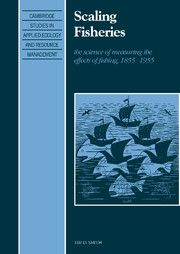Preface to the Paperback Edition
Scaling Fisheries, the science of measuring the effects of fishing, 1855-1955
Published online by Cambridge University Press: 22 September 2009
Summary
Scaling Fisheries, the science of measuring the effects of fishing, 1855-1955
When I finished Scaling Fisheries in 1994 I did not distinguish the history of fisheries biology from the history of fisheries. However, I was told then by those who seemed to know that I had written a useful first take on the former, but that I had not addressed the latter. Even though I was a scientist rather than a historian, they had assured me that this book would be valuable, if only as a source for real historians of science. As I began receiving reviews, I was watching for an enterprising historian of science to pick up the history for the remainder of the 20th century.
But no such historian appeared, and I was tempted from time to time to apply the approach I had taken in Scaling Fisheries to that period. After World War II, the praxis of fisheries biology had coalesced around what was necessary to implement one or the other of three single-species mathematical modeling approaches: surplus production, spawner-recruit and yield per recruit. But at the same time the seeds of expansion beyond fisheries biology into what would become fisheries science were being nurtured. The interesting developments in fisheries science for the last half of the 20th century were in those seeds, not in the many further elaborations of the dominant population models.
- Type
- Chapter
- Information
- Scaling FisheriesThe Science of Measuring the Effects of Fishing, 1855–1955, pp. xii - xvPublisher: Cambridge University PressPrint publication year: 1994

